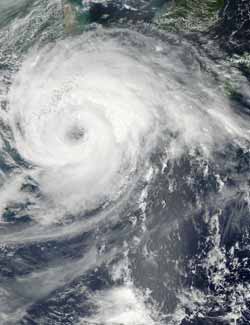NASA Sees Tropical Storm Haikui Closing in on China

When NASA's Aqua satellite passed over Typhoon Haikui on August 6, 2012 at 0435 UTC (12:35 a.m. EDT) the MODIS instrument onboard captured this image of the storm as it was approaching China.<br>Credit: NASA Goddard MODIS Rapid Response Team <br>
When NASA's Aqua satellite passed over Typhoon Haikui on August 6, 2012 at 12:35 a.m. EDT the Moderate Resolution Imaging Spectroradiometer (MODIS) instrument onboard captured an image of the storm as it was approaching China. The MODIS image clearly showed Haikui's ragged and elongated eye and the northwestern edge of the storm was already over southeastern China at that time.
By August 7 at 1500 UTC (11 a.m. EDT), Haikui dropped down to tropical storm status with maximum sustained winds near 60 knots (69 mph/111 kmh) as it approached the China coastline. Tropical-storm-force winds extend out as far as 100 nautical miles (115 miles/185 km) from the center.
Haikui was located approximately 225 nautical miles (259 miles/416.7 km) south-southeast of Shanghai, China, near 28.4 North latitude and 122.5 East longitude. It was headed northwest at 8 knots. Because Haikui was generating 28-foot-high (8.5 meter) seas, residents along the coast can expect dangerous surf, flooding, and coastal erosion.
The Joint Typhoon Warning Center forecasts Typhoon Haikui to maintain its current track and make landfall south of Zhoushan, China by 10 p.m. EDT/U.S. today, August 7 and then turn to the northeast.
Text Credit: Rob Gutro
NASA Goddard Space Flight Center, Greenbelt, Md.
Media Contact
All latest news from the category: Earth Sciences
Earth Sciences (also referred to as Geosciences), which deals with basic issues surrounding our planet, plays a vital role in the area of energy and raw materials supply.
Earth Sciences comprises subjects such as geology, geography, geological informatics, paleontology, mineralogy, petrography, crystallography, geophysics, geodesy, glaciology, cartography, photogrammetry, meteorology and seismology, early-warning systems, earthquake research and polar research.
Newest articles

Properties of new materials for microchips
… can now be measured well. Reseachers of Delft University of Technology demonstrated measuring performance properties of ultrathin silicon membranes. Making ever smaller and more powerful chips requires new ultrathin…

Floating solar’s potential
… to support sustainable development by addressing climate, water, and energy goals holistically. A new study published this week in Nature Energy raises the potential for floating solar photovoltaics (FPV)…

Skyrmions move at record speeds
… a step towards the computing of the future. An international research team led by scientists from the CNRS1 has discovered that the magnetic nanobubbles2 known as skyrmions can be…




















